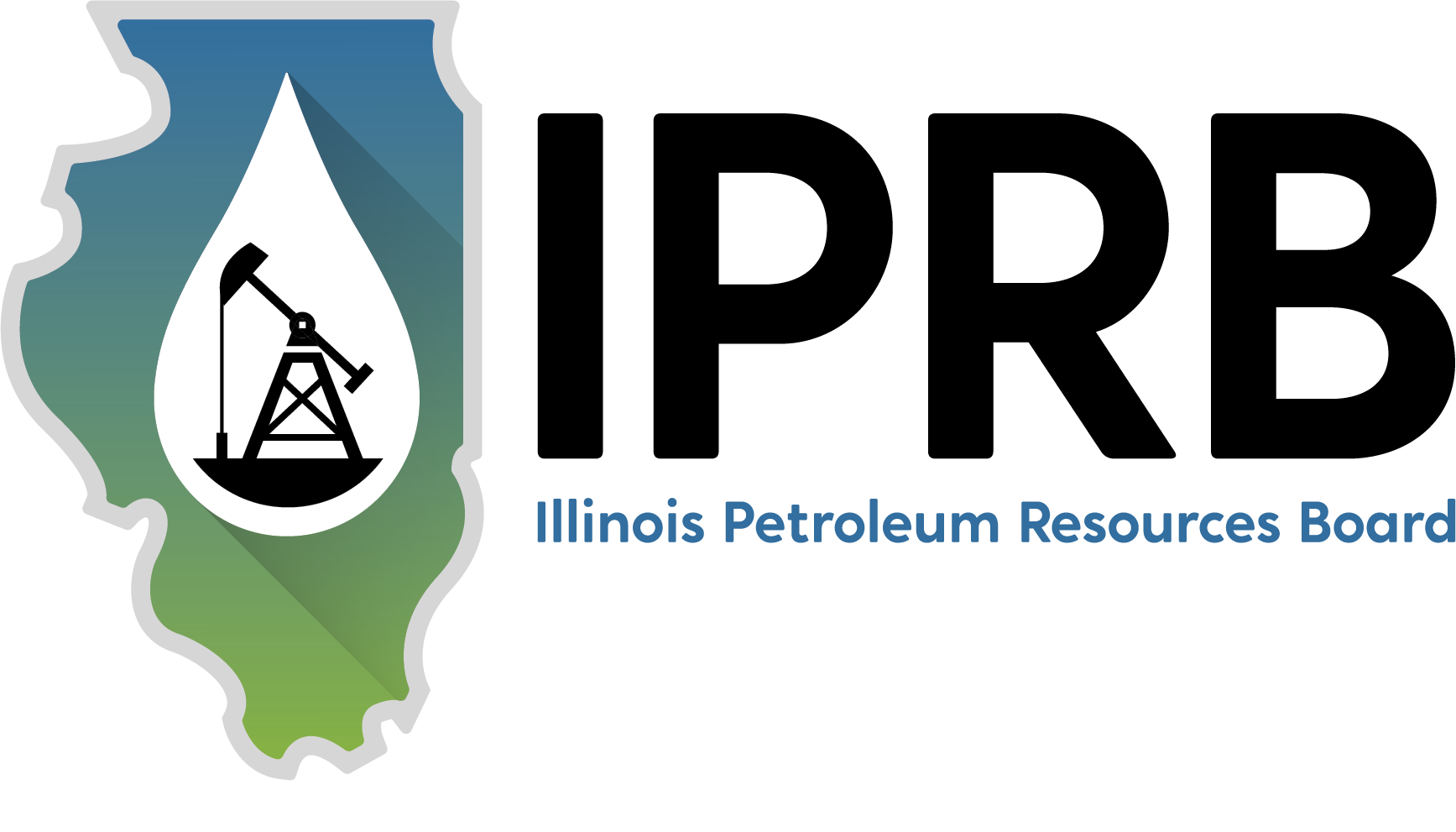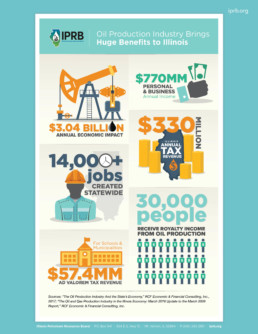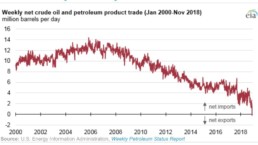Department of Energy Forecast Indicates Future of Oil and Natural Gas Is Very Bright
Given all the “Green New Deal” hype, one might be inclined to believe the future for oil and natural gas is very bleak. But the opposite is actually true.
The U.S. Department of Energy (DOE) recently released a report that shows fossil fuels – primarily oil and natural gas – will likely meet 79 percent of our energy needs in 2050. That represents just a one percent decline from fossil fuels’ energy consumption share last year.
As the following American Enterprise Institute graphics show, reports of oil and natural gas’ demise have no basis in reality.


Notably, the DOE’s projections aren’t dictated by who happens to occupy the White House. In fact, similar projections date back to the Obama administration. The DOE’s projections are based on cold, hard facts – and the fact remains that wind and solar’s fundamental limitations will keep abundant, dependable and affordable oil and natural gas in high demand for decades to come.
First and foremost, wind and solar offer no alternative whatsoever to oil and natural gas use in the industrial sector, or the roughly 6,000 petroleum-based products that are essential to our everyday lives. And as Real Clear Energy’s Jude Clemente recently noted, “perhaps the world's greatest energy irony is that oil and petrochemicals themselves are integral to renewables, electric cars, and the overall ‘energy transition’ itself.”
Indeed, petroleum and petroleum products are needed to manufacture solar panels, wind turbines, batteries, thermal insulation and electric vehicles. They are also needed to power the heavy machinery and large trucks necessary to mine the rare earth metals needed for electric car batteries.
But what about power generation? Many don’t realize that wind and solar are intermittent electricity-generation sources that must be backed up by natural gas generation when the wind isn’t blowing or the sun isn’t shining. It is for this simple reason that the head of one of the largest utilities in the United States, Excel CEO Ben Fowke, recently said, “The grid can’t be 100 percent renewable.”
So even assuming that electric vehicles will one day replace vehicles with internal combustion engines, their batteries would be charged by power that is at least partially generated by fossil fuels.
Based on current battery storage technology, Fowke acknowledges the maximum potential share of power generation generated by wind and solar would be 80 percent. And a recent Wood Mackenzie report finds that even in areas of the country with a “decent” mix of wind and solar potential, those places can only get to 50 percent wind and solar penetration without struggling. There is currently no complex electric power system in the world that operates with a wind or solar supply mix greater than 30 percent.
The fact remains that petroleum has been the largest source of United States energy consumption since 1950 for many reasons — the same reasons the DOE projects it will retain that title out to 2050 and beyond. The following EIA graphic pretty much tells the tale.
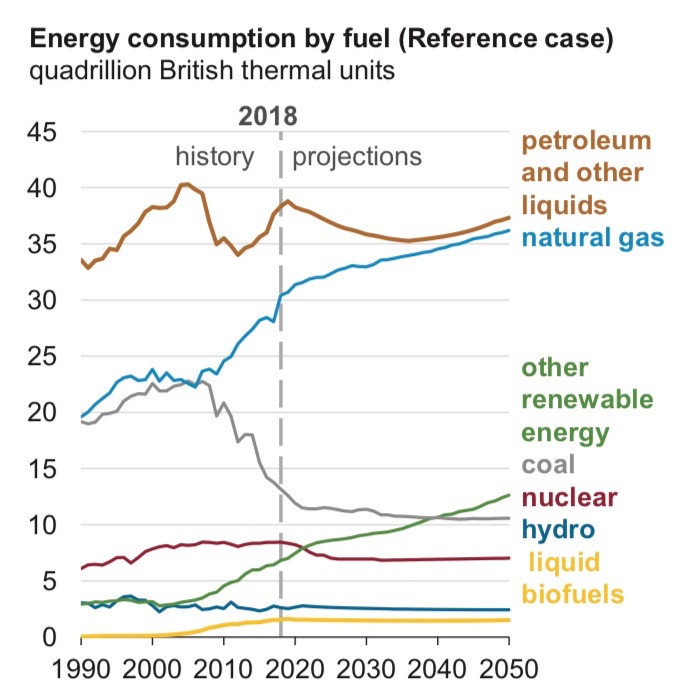
We are simply going to need a lot of oil and natural gas in the decades to come. And the only alternative to producing it here is importing in from countries that would love nothing more than to have us under their collective thumbs. Fortunately, the United States is positioned to limit, if not eliminate, the latter scenario like never before. Already the world’s undisputed leader in both oil and natural gas production, the DOE expects us to become a net exporter of energy next year and continue to retain that status through at least 2050.
Long-coveted energy independence is about to become the new normal.
To be clear, no energy source is perfect. But the United States has reduced greenhouse gas emissions more than any other country so far this century, all while growing economy an unprecedented 10 consecutive years. The only realistic path toward continued emissions reductions and economic stability is an all-of-the-above energy mix that includes natural gas, nuclear, hydropower and some form of carbon capture. “Green New Deal” advocates reject all of these in favor of exclusive use of limited wind and solar technologies that are currently meeting just three percent of our energy needs.
This is why when it comes to the “Green New Deal,” the rhetoric doesn’t reflect reality. Instead, reality reflects the myriad of reasons Americans need to support U.S. oil and natural gas development moving forward.
Paris Paradox: U.S. Leading in CO2 Reductions This Century While China’s Emissions Have Nearly Tripled
The United States’ withdrawal from the Paris climate agreement has generated considerable angst from environmental activists. But despite all the vitriol the Trump administration’s decision has yielded, America is more realistically positioned to meet Paris carbon dioxide reduction targets than virtually every nation that signed the non-binding agreement, proving once again that actions speak louder than words.
Case in point: China.
The Paris Agreement’s most prominent signatory has seen its CO2 emissions increase 180 percent since 2000, according to BP’s recently released 2019 Statistical Review of World Energy. No, that is not a typo – China’s CO2 emissions have nearly tripled from 3,361 million metric tons (mmt) in 2000 to 9,419 mmt last year.
In sharp contrast, the United States has led the world in CO2 reductions this century, slashing emissions 721 mmt since 2000.
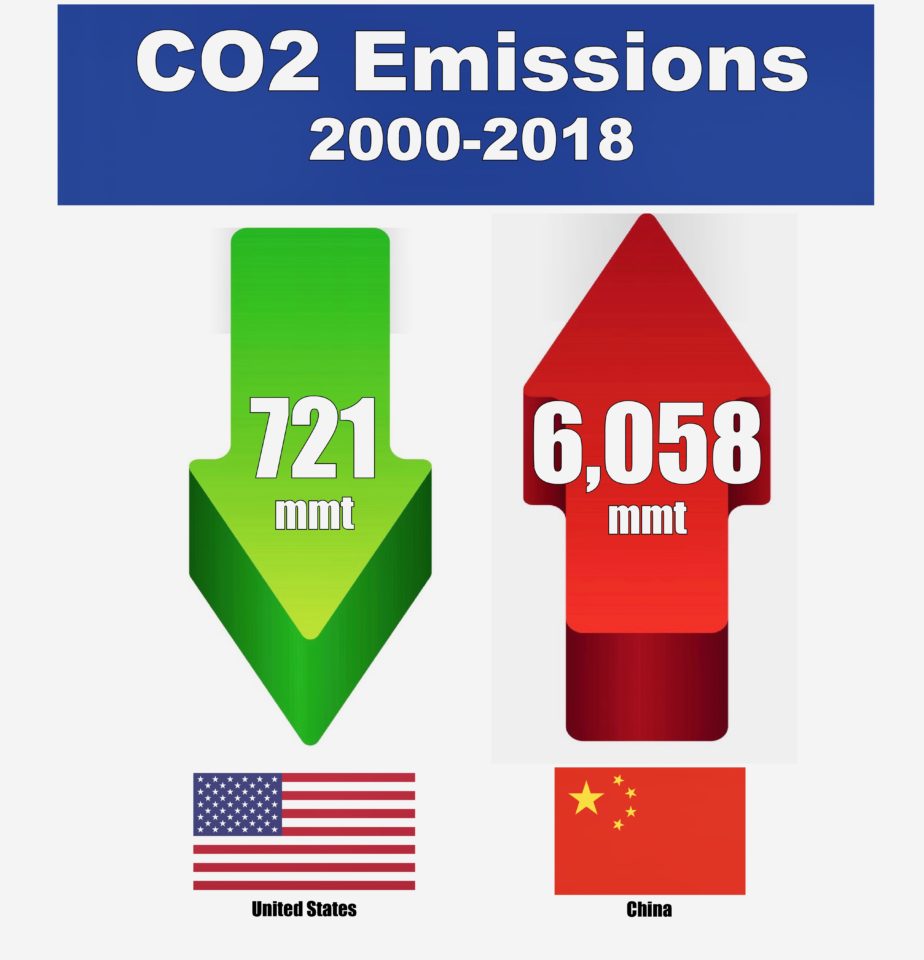
The United States has reduced energy-related CO2 emissions 14 percent since 2005, putting us in position to meet Paris reduction targets of 26 to 28 percent below 2005 levels by 2025.
As former New York City mayor and environmental activist Michael Bloomberg recently noted,
“We're half way there already and there's seven years left to go.”
The primary reason for this success is increased natural gas use, not renewable energy mandates similar to what would be imposed by a binding version of the Green New Deal, or what has been implemented, and failed, in Germany.
While supposedly “greener” European Union nations are coming up short of their Paris commitments, United Nations Energy Programme chief Erik Solheim has noted, “In all likelihood, the United States of America will live up to its Paris commitment, not because of the White House, but because of the private sector.”
Indeed, private sector innovation has made natural gas so abundant and affordable that the clean-burning fuel has quickly become the top source of U.S. power generation.
As a result, a 2018 U.S. Energy Information Administration (EIA) report shows that growth in natural gas consumption can be credited for 61 percent of the total 3.86 billion metric tons of electric generation CO2 reductions since 2005. Moving forward, the EIA projects U.S. energy-related CO2 emissions will decline this year (1.6%) and in 2020 (1%), while a 2018 analysis by researchers from Carnegie Mellon University (CMU) concludes that continued low natural gas prices – which are highly likely thanks to the shale revolution — could “put the country on the path to meeting the long-term goals” of the Paris Climate Accords.
Contrary to the oft-repeated “Keep It In the Ground” narrative, the U.S. oil and natural gas boom has actually helped the United States establish itself as the world leader in greenhouse gas reductions. In contrast, China — which has all sorts of gushing press for its renewable energy capacity additions — is building 300-plus coal power plants while watching its CO2 emissions skyrocket.
The United States all-of-the-above, market-driven model for greenhouse gas reductions has not only been effective, it is far more realistic than what Green New Deal advocates are proposing. For all the hype about a 100 percent renewable energy conversion, oil and natural gas will be needed for decades to come. Even under a Paris Agreement 100 percent compliance scenario, 48 percent of global energy will still come from oil and natural gas in 2040. This isn’t an industry talking point. It’s reality.
Which begs the question: Why is Michael Bloomberg – who once praised natural gas’ environmental benefits – now committing $500 million of his own fortune to shut down natural gas power plants when they are the No. 1 reason the U.S. leads the world in CO2 reductions this century?
Experts Give Green New Deal Advocates a Reality Check
The much-hyped Green New Deal is premised on the notion that the United States can achieve net zero greenhouse gas emissions in 10 years via a transition to 100 percent renewable energy, primarily wind and solar. But there is a big fundamental problem with that notion – it has no basis in reality. And you don’t have to take our word for it.
Numerous independent experts have recently emphasized the two primary reasons a 100 percent renewable energy transition is not possible. First, wind and solar simply aren’t reliable enough to exclusively power the grid. Wind and solar also provide no alternative whatsoever to the myriad of other sectors that fundamentally rely on fossil fuels and petroleum products, most notably the industrial sector.
These simple facts explain why every serious analysis has concluded that oil and natural gas will continue to be dominant sources of energy through at least 2040. Again, you don’t have to take our word for it. Here’s what a few experts have recently had to say.
Public Utility CEO: ‘The grid can’t be 100 percent renewable’
Ben Fowke, CEO of Xcel Energy — one of the largest utilities in the United States — recently debunked the claim that the power grid can convert to 100 percent wind and solar energy, stating plainly that, “The grid can’t be 100 percent renewable.”
This is because constant, reliable baseload power is absolutely necessary for utility-scale electricity generation due to demand fluctuations. Wind and solar power cannot be generated when the sun is not shining and the wind is not blowing, which also oftentimes happens to be when demand is highest. As E&E News recently reported:
“Peak solar and wind generating periods don't correspond with peak demand for electricity.
“Solar photovoltaic generation works only in daylight and best at high noon on sunny days, but grid operators say demand peaks later in the afternoon toward the evening hours, as people return from work and turn on their lights, appliances and air conditioners. Land-based wind power systems often see their strongest generation occur overnight, when people are asleep and grid demand is lowest."
Additionally, adequate battery technology to store wind and solar-generated energy at a utility-scale level simply doesn’t exist.
Fowke’s comment is all the more significant considering Xcel has committed to complete de-carbonization by 2050. Fowke has essentially conceded natural gas (combined with carbon capture) and/or nuclear generation will be needed to achieve his company’s stated goal. Green New Deal advocates – and the “Keep It In the Ground” movement in general – have rejected both natural gas and nuclear energy as options to decarbonize the grid, a striking example of rhetoric not reflecting reality.
Natural gas is — and will continue to be — needed to back up wind and solar power generation, a fact that prompted former Clinton White House advisor Paul Bledsoe to say “it's utterly disingenuous of the left to pretend we can get rid of natural gas anytime soon.”
Renewable energy advocates often point to falling wind and solar costs as evidence that they are viable options, but Breakthrough Energy Coalition chairman Microsoft founder Bill Gates recently countered, saying,
“That’s nothing… that doesn’t solve the reliability problem.”
The International Energy Agency agrees, as it recently issued a report that expresses concerns about emission reduction strategies that rely heavily on intermittent wind and solar energy.
Bill Gates: ‘There is no substitute for how the industrial economy runs today’
Even if a 100 percent renewable conversion of the electricity grid was realistic, the fact that such a conversion would do nothing to reduce industrial emissions is consistently ignored by Green New Deal advocates. As Gates recently said:
“Electricity is just 25 percent of greenhouse gas emissions. There is no substitute for how the industrial economy runs today.”
“Do you guys on Wall Street have something in your desks that makes steel? Where is fertilizer, cement, plastic going to come from? Do planes fly through the sky because of some number you put in a spreadsheet?”
More than 6,000 products are derived from and/or manufactured with petroleum — including key components of infrastructure needed to generate renewable energy. As the IEA recently noted,
“Petrochemicals are particularly important given how prevalent they are in everyday products. They are also required to manufacture many parts of the modern energy system, including solar panels, wind turbines, batteries, thermal insulation and electric vehicles.”
In other words, there is no wind and solar infrastructure if we “Keep It In the Ground.”
This is precisely why the IEA projects global oil demand growing substantially through at least 2040, even taking the potential widespread electrification of the transportation sector into consideration.
Conclusion
The Green New Deal has thrust the idea of a 100 percent renewable energy conversion into the mainstream consciousness. But it can’t be emphasized enough that wind and solar account for just two percent of the world’s energy, and such a transition is unprecedented for a reason.
No country has decarbonized its electricity supply exclusively with wind and solar. The two countries that have come closest — Sweden and France – have done so largely with nuclear and hydro energy (83 and 82 percent respectively, with just 12 and six percent, respectively, attributable to wind and solar). And Germany, the most notable nation that has attempted to decarbonize primarily with wind and solar, has fallen well short of its emissions reduction targets while watching energy prices soar.
Far from renewable bashing, it is important for the public to understand the limitations of wind and solar and understand that we will need a whole lot of oil and natural gas for a long time to come. That is why it is so important to counter the “Keep It In the Ground” agenda with the facts. Otherwise, we’ll end up once again importing most of our oil and gas from hostile nations, while energy prices soar and our emissions reductions fall well short of what Green New Deal advocates have promised.
Fayette County Oil Production Has Provided Millions in Interest-Free Student Loans
The United States is in the midst of a full-blown student loan debt crisis. In fact, elevated interest rates have contributed to the highest level of collective student loan debt ever. But fortunately for residents of Fayette County, interest-free loans made possible by local oil production continues to ease the increasing financial burden of obtaining a higher education.
The Ella G. McKee Foundation has provided millions of dollars in no-interest student loans to qualifying Fayette County residents since 1971, including more than $3 million in loans to 400-plus residents since 2002. The primary source of funds for the McKee Foundation has been the royalty from mineral interests held by the McKee family in southeast Fayette County on the southern edge of the historic Louden oilfield.
First National Bank of Vandalia Trust & Branch Manager Jay Joliff doesn’t hesitate to acknowledge that the McKee Foundation has made a difference in Fayette County.
“For nearly 50 years, the Ella McKee Foundation has provided interest free student loans to around 1,000 Fayette County residents,” Joliff said. “There have been countless stories from people whose road to success began with the Ella McKee loan.”
Background
The McKee Foundation was established by longtime Fayette County resident Ellla McKee prior to her death in 1969. McKee chose to bequeath a large sum of money to the First National Bank of Vandalia to invest and reinvest the assets and disburse the income “solely for educational purposes and no other,” according to the Vandalia Leader-Union.
The primary source of the monies used to establish the McKee Foundation was the McKee family’s prolific 87-acre lease, located on the southern edge of the Loudon oilfield in southeastern Fayette County.
After the McKee family leased its mineral rights to Texaco in the late 1930s, the company brought in nine successful oil wells between 1939 and 1940. Those wells cumulatively produced 2.35 million barrels of oil through 1962, with many averaging more than 200 barrels per day at their peak, and McKee receiving 12.5 percent royalty from the production.
In 1963, Texaco consolidated 10 separate leases into the Louden South Unit, with McKee receiving just under 2.1 percent of the total unit royalty. Production from the Loudon South Unit peaked at 641 barrels per day in 1966 and has totaled more than 15 million barrels to date.
This production obviously generated a large sum of income for the McKee family, much of which was generously dedicated to helping less fortunate county residents achieve a better quality of life through higher education.
Why It Matters
The cost of obtaining a higher education have ballooned in recent years, prompting more and more college students to take out large loans to pay for their educations, many of which come along with high interest rates that leave them hopelessly in debt.
Outstanding student loan balances have exploded more than 500 percent over the past 15 years, and 44 million U.S. borrowers owe a total of $1.6 trillionin outstanding student loan debt. Illinoisans collectively owe $49 billion in student loan debt. Annual tuition at four-year, in-state public colleges averages more than $10,000, a total that doesn’t include room and board and other necessary expenses.
In Fayette County, these exploding costs are compounded by the fact that a large portion of the population lacks the level of income needed to pay for college. Fayette County’s poverty rate sits at 17.8 percent, more than five percentage points above the national average.
Fortunately, the Ella McKee Foundation — which was made possible by Fayette County oil production — provides a pathway for lower-income residents to pursue a higher education.
How to Apply
In order to qualify for a student loan through the Ella McKee Foundation, applicants must have been four-year residents of Fayette County prior to applying and must be without adequate funds or sources to meet the costs of securing a college, university, or other form of post-high school education. Click here for an application form and more details on the application process.
Loans are paid out on a monthly basis during the school year for a maximum of eight semesters. Though the McKee Foundation has long been established, these interest-free student loans continue to be underutilized.
“We encourage more students from Fayette County to contact us about how they might qualify for the foundation loan,” Joliff said.
IPRB is dedicated to sharing the story of the Illinois oil production industry’s positive economic impact. Some of the benefits – such as the jobs and revenue the industry continues to generate – are more obvious than others. The Ella McKee Foundation is just one of the many under-the-radar examples of how the Illinois oil industry benefits the communities in which it operates. IPRB looks forward to sharing similar stories in the coming months.
Note: The fourth paragraph of the "Background" section of this blog post was corrected on June 4 to accurately reflect the royalty percentage paid to McKee from the Loudon South Unit.
Fact Checking the ‘Keep It In the Ground’ Movement
“Keep It In the Ground” activists continue to spread misinformation about responsible oil and natural gas development both in Illinois and throughout the United States. IPRB will maintain and update the following living document countering “Keep It In the Ground” myths with the facts.
UPDATE: Aug. 1, 2019
MYTH: “In 2005, the Bush/ Cheney Energy Bill exempted natural gas drilling from the Safe Drinking Water Act. It exempts companies from disclosing the chemicals used during hydraulic fracturing. Essentially, the provision took the Environmental Protection Agency (EPA) off the job. It is now commonly referred to as the Halliburton Loophole.” — www.Gaslandthemovie.com
FACT: Hydraulic fracturing has never in its nearly 65-year history been regulated by the U.S. Environmental Protection Agency’s Underground Injection Control (UIC) program under the Safe Drinking Water Act. That’s because the Safe Drinking Water Act was never meant to regulate hydraulic fracturing. Language adopted by bipartisan majorities of Congress in 2005 simply reaffirmed that fact. States currently have – and have always had – primary regulatory authority over hydraulic fracturing. The hydraulic fracturing process is also subject to no fewer than eight federal regulations.
UPDATE: May 23, 2019
MYTH: The U.S. oil and natural gas boom has led to a dramatic spike in methane emissions, and methane leaks from oil and natural gas systems make natural gas worse for the climate than other fuels.
FACT: Natural gas has indisputable climate advantages over other traditional fuels and U.S. methane emissions have not spiked since the shale revolution began. The International Energy Agency has affirmed the climate benefits of natural gas, even taking into account methane leakage, stating that natural gas “generates far fewer greenhouse-gas emissions than coal when generating heat or electricity, regardless of the timeframe considered.” A recent NOAA study also finds that there has been no statistically significant increase in U.S. methane emissions since the domestic oil and gas boom began. This finding echoes the latest U.S. Environmental Protection Agency data, which shows U.S. oil and natural gas system methane emissions have declined two percent since 2005 at the same time oil production has increased 81 percent and natural gas production has spiked 55 percent.
MYTH: The U.S. oil and natural gas boom has impeded renewable energy growth.
FACT: The U.S. oil and natural gas boom has actually accelerated renewable energy growth. A 2016 National Bureau of Economic Research report found that renewable electricity generation has grown at roughly the same rapid rate as natural gas-fired electrical generation over the past two-plus decades. This can be explained by the fact that renewable sources of energy such as wind and solar are intermittent and require natural gas backup for times when the wind doesn’t blow and the sun doesn’t shine. As the paper notes, “… renewables and fast-reacting fossil technologies appear as highly complementary and that they should be jointly installed to meet the goals of cutting emissions and ensuring a stable supply.” Because the shale revolution has made natural gas abundant and affordable, renewable energy generation capacity has increased dramatically over the past decade.
As former Clinton White House advisor Paul Bledsoe recently said of the shale revolution: “It's a key reason renewables have grown so quickly.”
ORIGINAL POST: May 16, 2019
MYTH: We can live without fossil fuels.
FACT: Not only are fossil fuels projected to continue to meet nearly 80 percent of our energy needs through at least 2040, more than 6,000 products are derived from and/or manufactured with petroleum — including key components of infrastructure needed to generate renewable energy, such as solar panels, wind turbines, batteries, and electric vehicles.” [1] [2]
MYTH: Hydraulic fracturing (fracking) poses a systemic threat to groundwater.
FACT: More than two dozen scientific studies have concluded fracking poses no major threat to groundwater. Most notably, a landmark 2016 U.S. Environmental Protection Agency study concluded that, “[H]ydraulic fracturing operations are unlikely to generate sufficient pressure to drive fluids into shallow drinking water zones.” The EPA reached this conclusion even after expanding the definition of fracking to include a wide range of other oilfield activities, demonstrating the safety of the entire development process. [3] [4]
MYTH: Oil demand has peaked and is in irreversible decline
FACT: Oil demand crossed the 100 million barrels per day threshold for the first time ever last year and is expected to increase to just under 110 million barrels per day by 2030. [5]
MYTH: The United States can immediately convert to 100 percent renewable energy.
FACT: Reliability and land use issues make a 100 percent renewable transition virtually impossible. Fossil fuel backup (usually natural gas) is necessary for wind and solar power generation due to the intermittent nature of both. It is also estimated that a 100 percent renewable conversion would require as much as one-third of the United States land space to be covered by solar panels and wind turbines. [6]
MYTH: The United States oil and natural gas boom has exacerbated climate change.
FACT: The United States leads the world in carbon dioxide reductions this century, a trend that has largely been attributed to increased natural gas use. The United States cut its carbon dioxide emissions 862 million tons from 2005 to 2017, a 14 percent decline. In fact, former New York mayor Michael Bloomberg even recently noted the United States is meeting the goals of Paris Climate Accords despite the Trump administration’s plans to withdraw from the non-binding agreement. [7] [8]
The United States' greenhouse gas emissions cuts have “been the largest in the history of energy” over the past 10 years and have come at the same time domestic oil production has increased more than 80 percent. [9]
Illinois Specific “Keep It In the Ground Claims”
CLAIM: “You can be half a mile from a well and a horizontal well can go right under your property and you wouldn’t know about it. So there are no defensive actions you can take, like getting a test on your water wells.” — William Rau, Illinois Peoples’ Action [10]
FACT: Disclosure of the location and track of all horizontal well bores is a required aspect of the permitting process. Therefore, landowners in Illinois are fully aware if a horizontal well is drilled under their property. The suggestion that subsurface trespass is occurring is false. [11]
CLAIM: “[T]he (fracking) process also comes with a risk of exposure to radioactive elements… If you look at what has been happening in recent years in Pennsylvania and North Dakota, the radioactive contamination coming out of those wells has been a disaster for those communities.” — Rich Whitney, Vice Chairman Illinois Green Party and Southern Illinoisans Against Fracturing Our Environment steering committee member [12]
FACT: A recent peer-reviewed Pennsylvania Department of Environmental Protection study states “there is little potential for harm to workers or the public from radiation exposure due to oil and gas development.”[13]
CLAIM: “Low and medium volume fracking is governed by the antiquated 1951 Oil and Gas Act. Using that act’s confidentiality clause, fracking companies can frack in secret for a period of 2 years without disclosing any information to the public.” — Illinois Coalition Against Fracking [14]
FACT: All information pertaining to hydraulic fracturing activities in Illinois is provided to the Illinois Department of Natural Resources and can be accessed by the public.
CLAIM: “Residents in the vicinity of wells with horizontal or directional extensions in other states have suffered adverse health and/or declines in their property values.” — Illinois Coalition Against Fracking [15]
FACT: Several state departments of environmental protection have installed air monitors at well sites and found that emissions during oil and natural gas development do not exceed public health thresholds. There is also no research that indicates that the health of people living near oil and gas wells has been – or is likely to be – harmed by exposure to the additives mixed in with fracking fluid. A 2016 University of Chicago study also finds that home values near unconventional oil and gas development actually increased six percent after development began. All told, a vast majority of major U.S. shale states have seen their property values surge — the complete opposite of what fracking opponents have repeatedly claimed. [16] [17] [18] [19]
CLAIM: “Over 1000 scientific, medical and media findings demonstrate the risks of fracking since the passage of the Illinois Hydraulic Fracturing Regulatory Act on 6/16/12.” — Illinois Coalition Against Fracking [20]
FACT: Colorado Department of Public Health and Environment (CDPHE) officials have noted that the collection of research from which this claim is based is “hypothetical and not scientific and compiled by groups with an anti-fracking bias.” [21] American Petroleum Institute toxicologist Uni Blake's review of the collection of research revealed that just 31 of the 1,500 “scientific reports, peer-reviewed studies and investigative journalism reports” can be defined as legitimate science – and each of those studies has been criticized by public health officials for significant limitations and methodological flaws.
[1] https://www.eia.gov/outlooks/ieo/pdf/0484(2017).pdf
[2] https://www.iea.org/newsroom/news/2018/october/petrochemicals-set-to-be-the-largest-driver-of-world-oil-demand-latest-iea-analy.html
[3] http://www.ipaa.org/fracking/
[4] https://cfpub.epa.gov/ncea/hfstudy/recordisplay.cfm?deid=332990
[5] https://www.iea.org/newsroom/news/2018/october/petrochemicals-set-to-be-the-largest-driver-of-world-oil-demand-latest-iea-analy.html
[6] https://www.latimes.com/business/la-fi-100-clean-energy-gas-plants-20181220-story.html
[7] https://www.bp.com/en/global/corporate/energy-economics/statistical-review-of-world-energy.html
[8] https://freebeacon.com/issues/bloomberg-u-s-meeting-paris-climate-goals-without-being-part-of-the-agreement/
[9] https://oilprice.com/Latest-Energy-News/World-News/IEA-Chief-US-Emission-Cuts-The-Largest-In-Energy-History.html?fbclid=IwAR2xM9LbHHT7zpnyRi2eQ0kGnvxatZY38IIW9ICpNmXyUrQ1PBASPE5Dyds
[10] http://www.nprillinois.org/post/activists-call-smaller-scale-fracking-transparency#stream/0
[11] https://www.dnr.illinois.gov/.../OGF-OG10PermitApplicationGuidanceForm.pdf
[12] https://mothernature.com/2017/06/groups-warn-of-radiation-exposure-associated-with-fracking/
[13] http://www.elibrary.dep.state.pa.us/dsweb/Get/Document-105822/PA-DEP-TENORM-Study_Report_Rev._0_01-15-2015.pdf
[14] http://ilbanfracking.org/wp-content/uploads/2019/02/HB282_Fact_Sheet_edited.pdf
[15] http://ilbanfracking.org/wp-content/uploads/2019/02/HB282_Fact_Sheet_edited.pdf
[16] https://www.energyindepth.org/new-data-debunks-claims-that-fracking-drives-down-property-values/?154
[17] https://eidhealth.org/wp-content/uploads/2017/04/Positive-Health-Compendium.pdf
[18] https://books.google.com/books?id=8ERADwAAQBAJ&pg=PT64&lpg=PT64&dq=To+date,+there+is+no+research+that+indicates+that+the+health+of+people+living+near+oil+and+gas+wells+has+been+%E2%80%94+or+is+likely+to+be+%E2%80%94+harmed+by+exposure+to+the+chemicals+mixed+in+with+fracking+fluid&source=bl&ots=xoevqIi4ZH&sig=bwZQcehXZ8MLhMHZRoy_MZDWj60&hl=en&sa=X&ved=0ahUKEwiegYaJjeXbAhUUIjQIHVblBCEQ6AEIcjAL#v=onepage&q=To%20date%2C%20there%20is%20no%20research%20that%20indicates%20that%20the%20health%20of%20people%20living%20near%20oil%20and%20gas%20wells%20has%20been%20%E2%80%94%20or%20is%20likely%20to%20be%20%E2%80%94%20harmed%20by%20exposure%20to%20the%20
[19] https://epic.uchicago.edu/sites/default/files/UCH-120116_FrackingResearch_final_1.pdf
[20] http://ilbanfracking.org/wp-content/uploads/2019/02/HB282_Fact_Sheet_edited.pdf
[21] https://denver.cbslocal.com/2018/10/23/reality-check-proposition-112/#.W9BmpZeTzAI.twitter
Hometown Energy Video Podcast Tells True Story of Illinois’ Oil Production Industry
Public perceptions are driven by what people see in the media. And over the past 10 years, all folks have seen is headlines about the horizontal drilling and high volume hydraulic fracturing that has driven American oil production to record-shattering levels.
This has no doubt crystalized the “Big Oil” perception of the U.S. oil and natural gas industry. But that perception couldn’t be further from reality in the Land of Lincoln, where conventional vertical development rules and small, locally-owned companies make up the heart of the Illinois Basin.
In fact, a 2016 RCF Economic & Financial Consulting economic impact report found that of the 4,000-plus direct oil production industry jobs in the Land of Lincoln, those jobs are split evenly between mostly small, locally-owned businesses and independent contractors.
It is with the latter facts and the general disconnect between public perception and reality in mind that the Illinois Petroleum Resources Board and IOGA have launched Hometown Energy, a new video podcast that will feature in-depth personal stories from throughout the Illinois Basin that convey the true story of the Illinois oil production industry.
In contrast to what’s happening in other states, the Illinois oil industry remains much the same as it was decades ago: largely family-owned, hyper local and interwoven with the communities, providing critical jobs and tax revenues in areas of the state desperately in need of both.
And despite the “Keep It In the Ground” movement’s continued efforts to drag Illinois into the fight over shale development – just take a look at this year’s proposed legislation! – there is no such development occurring in Illinois, and will likely be no such development anytime in the near future.
We have to communicate that fact to the general public, otherwise the “Keep It In the Ground” movement will be all-too-happy to continuing to paint our industry’s perception with a deceptive brush.
Our debut “Hometown Energy” episodes featured interviews with Gesell Pump Sales and Service co-owner Brad Gesell and outgoing IOGA president and longtime Illinois Basin attorney Craig Hedin. With a combined 80 years of experience in the Illinois oil industry, there are few others more qualified to tell the true story of our industry.
Future episodes will feature Chris and Ryan Mitchell from Geo Mitchell Drilling – one of the many multi-generational family-owned businesses in the Illinois Basin – and Travis Thompson of Thompson Oil…
Sharing the Story of the Illinois Oil Industry’s Positive Economic Impact
Illinois has struggled mightily to create jobs, adequately fund public schools and generate tax revenue for years. In contrast, the Land of Lincoln’s oil production industry has been a reliable source of thousands of jobs and millions in tax revenue for education and public services for more than 100 years.
It is with these facts in mind that the Illinois Petroleum Resources Board (IPRB) has prioritized sharing the story of the positive economic impact of Illinois’ oil production industry.
Our industry is clearly part of the solution to the state’s most pressing problems — a fact our new governor and legislature should keep in mind the next time “Keep It In the Ground” groups push them to legislate the industry out of existence altogether.
A 2016 RCF Economic & Financial Consulting economic impact report finds Illinois’ oil production industry generates $770 million in personal and business income annually. It is also responsible for $330 million in state tax revenue a year, including millions for woefully underfunded school districts in producing counties. Land of Lincoln oil production also provides royalty income for more than 30,000 Illinoisans.
And as we “downstate” Illinoisans are aware, the industry continues to be a significant source of good-paying jobs. The Illinois oil production industry is responsible for more than 14,000 jobs throughout the state, and a vast majority of the state’ 4,000 direct oil production jobs are concentrated in Southern Illinois.
These figures are nothing to sneeze at – especially in a state whose name has become synonymous with economic ineptitude.
The industry has a great story to tell. But the key will be effectively sharing it, not only with upstate Illinoisans, but folks right here in the Illinois Basin.
IPRB has been sharing the key findings of the RCF report through traditional and social media channels for the past several months. We have recently developed an infographic and fact sheet highlighting the industry’s economic impact and encourage everyone to share them widely. Based on the feedback we’ve received so far, it is clear that many folks across the southern region of the state where oil production is taking place are not only genuinely surprised – but completely unaware – of the magnitude of the industry’s economic impact.
That needs to change moving forward for a myriad of reasons.
First and foremost, make no mistake: the state and national oil and natural gas industry faces an existential threat from the well-funded and relentless “Keep It In the Ground” movement. Industry supporters need to educate themselves – and the public at large – about the benefits of our industry, and do so with dogged determination. Nobody else is going to do it for us.
In the absence of effective dissemination of facts, “Keep It In the Ground” fearmongering will fill the void and negatively influence policy. We are effectively facing a political movement that argues that eliminating an industry that has generated billions in economic activity over 100 years is justifiable in exchange for addressing climate change — even though eliminating Illinois’ oil industry would have absolutely no effect on oil and gas consumption or carbon dioxide emissions.
Facts matter, and the fact remains that the U.S. Department of Energy projects the United States will get more than 50 percent of its energy from oil and gas in 2050. Even under the Paris Climate Accords scenario, 48 percent of global energy will come from oil and gas in 2040. Why? Because wind and solar energy are intermittent sources of energy that cannot be relied upon to power modern society. Put another way, what proponents of the "Green New Deal" are pushing is completely unrealistic.
That’s why it’s incumbent upon us to counter the fear-mongering with fact-mongering. And IPRB vows to be a key resource to facilitate the latter counter-strategy as this battle continues.
Be sure to check out IPRB’s new Facebook and Twitter pages for more details on the RCF economic impact study and visit iprb.org to download the fully report.
Unpacking America’s energy renaissance and Illinois’ role moving forward
The United States ended 2018 as the world’s top crude oil producer, a status it hasn’t enjoyed since 1973. America was also a weekly net petroleum exporter earlier this month for the first time since the Truman administration some 75 years ago. We also lead all major nations in carbon dioxide reductions this century.
If someone had told you back in 2008 that those three things were going to happen 10 years down the road, it probably would have sounded as believable as saying Donald Trump would be elected president.
But thanks to the marriage of hydraulic fracturing and horizontal drilling, all three have become a reality. In just a decade’s time, the United States’ fortunes have transitioned from that of energy scarcity to energy abundance — and it’s something worth celebrating.
Click here to read the full Southern Illinoisan op-ed.
